BAC 305: International Corporate Failure Case Study Report
VerifiedAdded on 2022/12/20
|16
|4207
|36
Report
AI Summary
This report provides an in-depth analysis of corporate failures, focusing on three prominent cases: Lehman Brothers (United States), HIH Insurance (Australia), and Paramalat (Italy). The report examines the factors that led to the collapse of each company, including accounting irregularities, poor management, and audit failures. It delves into the specific actions and decisions that contributed to these failures, such as over-leveraging in Lehman Brothers, fraudulent activities within HIH Insurance, and financial misrepresentation at Paramalat. The report also explores the reasons why these irregularities were not detected by auditors, if applicable, and what actions auditors should have taken to prevent such practices. Furthermore, it investigates the subsequent actions taken by regulators to address these problems and prevent similar occurrences in the future. The conclusion highlights the common themes and lessons learned from these corporate failures, emphasizing the importance of strong corporate governance, ethical behavior, and effective auditing practices. The analysis is supported by academic journals and relevant sources to provide a comprehensive understanding of these significant financial scandals.
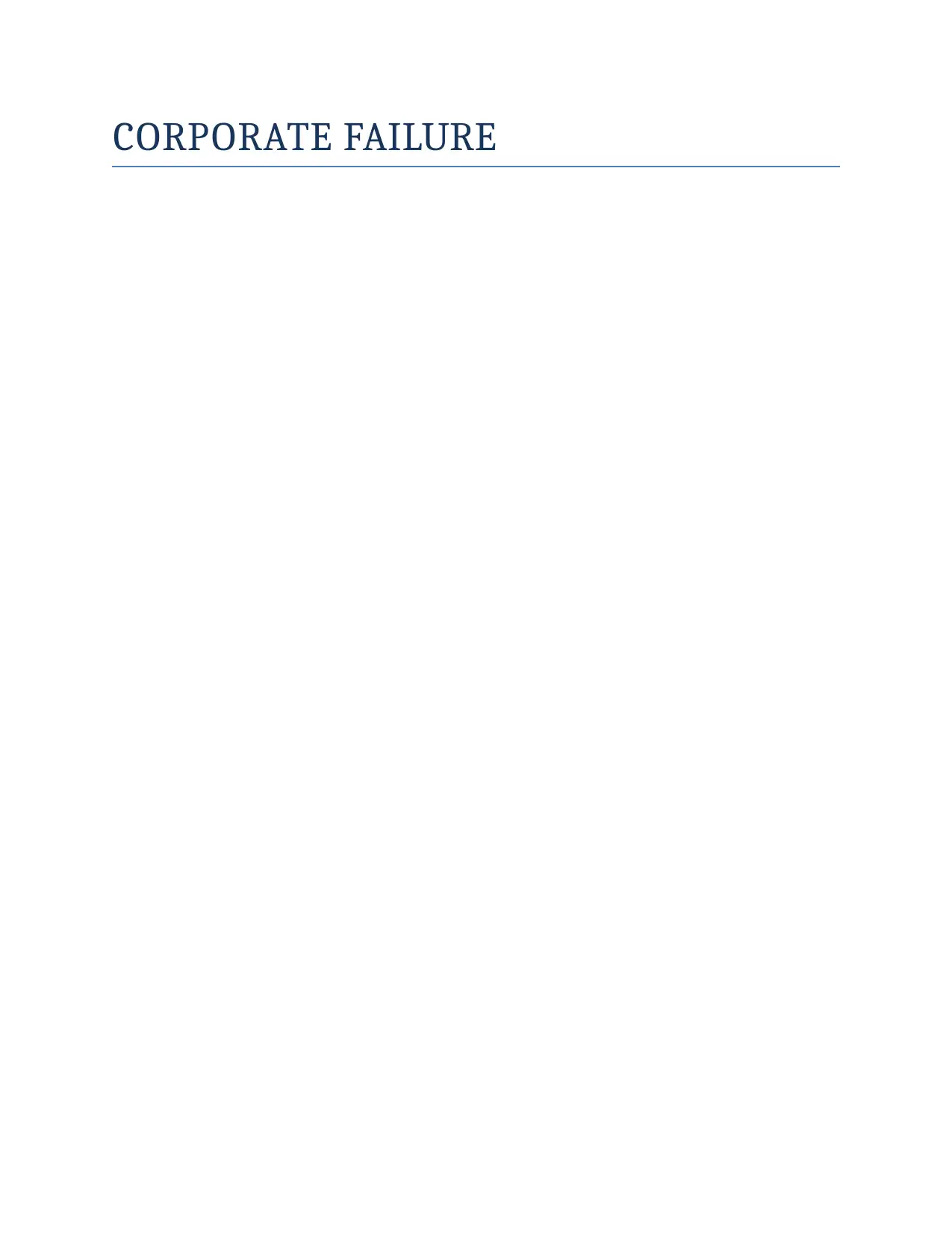
CORPORATE FAILURE
Paraphrase This Document
Need a fresh take? Get an instant paraphrase of this document with our AI Paraphraser

EXECUTIVE SUMMARY
This assignment emphasizes on various scandals that have taken place in the corporate sector on
an international platform. Due to the magnitude and intensity of deception involved towards its
stakeholders through false augmentation in goodwill, these corporate scams have gained
popularity and left its mark in the history of its national corporate culture. It also puts forward the
role internal management and auditors in provide assistance whether directly or indirectly in
such scandals to become reality with such tremendous loss to its concerned stakeholders. The
three cases discussed here are of Lehmann Brothers from the United States, the HIH Insurance
and the Paramalat case from Italy. The last section concludes how these scandals pose threats to
its investors and general public leaving behind many examples of failures from management’s
and auditor’s team.
This assignment emphasizes on various scandals that have taken place in the corporate sector on
an international platform. Due to the magnitude and intensity of deception involved towards its
stakeholders through false augmentation in goodwill, these corporate scams have gained
popularity and left its mark in the history of its national corporate culture. It also puts forward the
role internal management and auditors in provide assistance whether directly or indirectly in
such scandals to become reality with such tremendous loss to its concerned stakeholders. The
three cases discussed here are of Lehmann Brothers from the United States, the HIH Insurance
and the Paramalat case from Italy. The last section concludes how these scandals pose threats to
its investors and general public leaving behind many examples of failures from management’s
and auditor’s team.
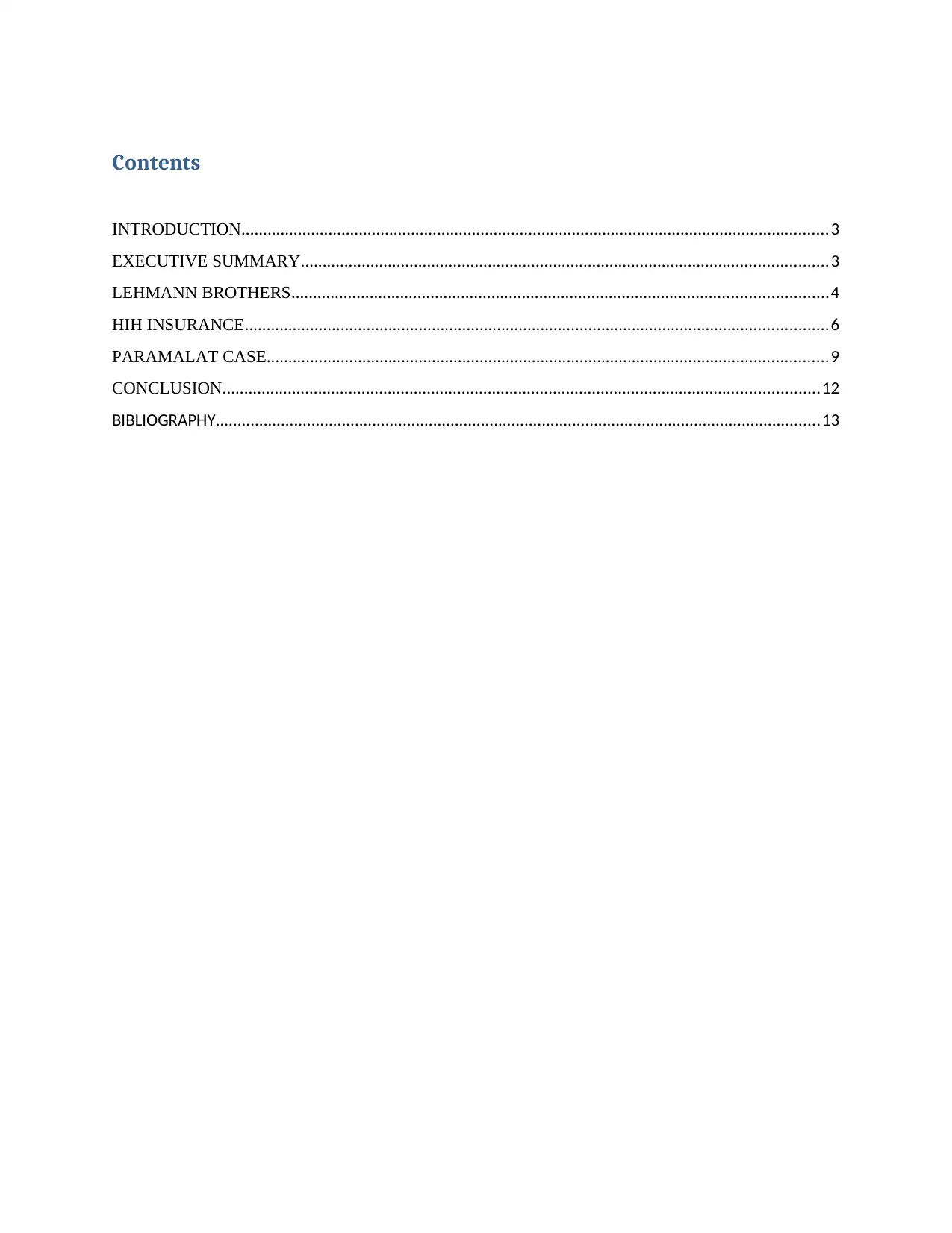
Contents
INTRODUCTION.......................................................................................................................................3
EXECUTIVE SUMMARY.........................................................................................................................3
LEHMANN BROTHERS...........................................................................................................................4
HIH INSURANCE......................................................................................................................................6
PARAMALAT CASE.................................................................................................................................9
CONCLUSION.........................................................................................................................................12
BIBLIOGRAPHY...........................................................................................................................................13
INTRODUCTION.......................................................................................................................................3
EXECUTIVE SUMMARY.........................................................................................................................3
LEHMANN BROTHERS...........................................................................................................................4
HIH INSURANCE......................................................................................................................................6
PARAMALAT CASE.................................................................................................................................9
CONCLUSION.........................................................................................................................................12
BIBLIOGRAPHY...........................................................................................................................................13
⊘ This is a preview!⊘
Do you want full access?
Subscribe today to unlock all pages.

Trusted by 1+ million students worldwide
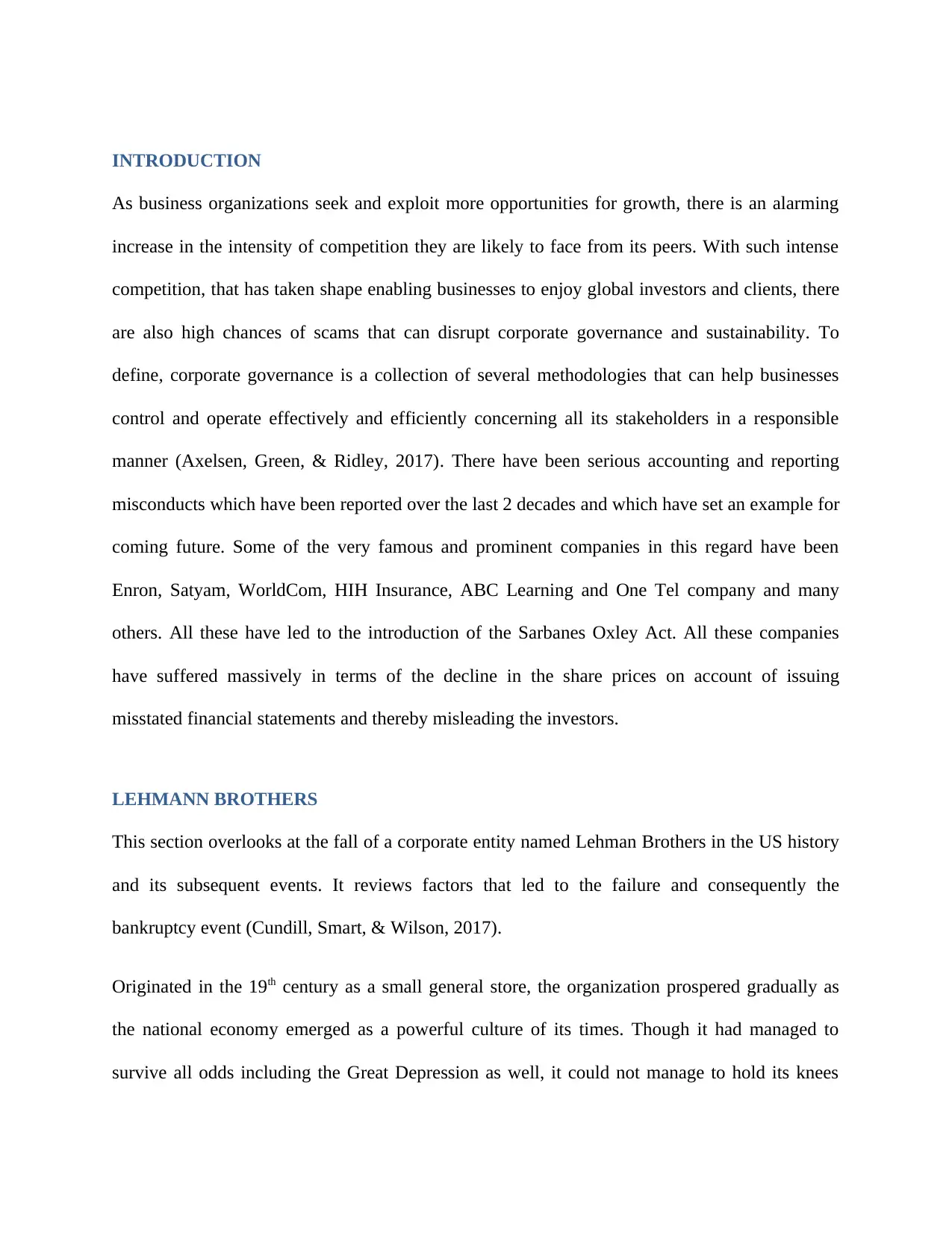
INTRODUCTION
As business organizations seek and exploit more opportunities for growth, there is an alarming
increase in the intensity of competition they are likely to face from its peers. With such intense
competition, that has taken shape enabling businesses to enjoy global investors and clients, there
are also high chances of scams that can disrupt corporate governance and sustainability. To
define, corporate governance is a collection of several methodologies that can help businesses
control and operate effectively and efficiently concerning all its stakeholders in a responsible
manner (Axelsen, Green, & Ridley, 2017). There have been serious accounting and reporting
misconducts which have been reported over the last 2 decades and which have set an example for
coming future. Some of the very famous and prominent companies in this regard have been
Enron, Satyam, WorldCom, HIH Insurance, ABC Learning and One Tel company and many
others. All these have led to the introduction of the Sarbanes Oxley Act. All these companies
have suffered massively in terms of the decline in the share prices on account of issuing
misstated financial statements and thereby misleading the investors.
LEHMANN BROTHERS
This section overlooks at the fall of a corporate entity named Lehman Brothers in the US history
and its subsequent events. It reviews factors that led to the failure and consequently the
bankruptcy event (Cundill, Smart, & Wilson, 2017).
Originated in the 19th century as a small general store, the organization prospered gradually as
the national economy emerged as a powerful culture of its times. Though it had managed to
survive all odds including the Great Depression as well, it could not manage to hold its knees
As business organizations seek and exploit more opportunities for growth, there is an alarming
increase in the intensity of competition they are likely to face from its peers. With such intense
competition, that has taken shape enabling businesses to enjoy global investors and clients, there
are also high chances of scams that can disrupt corporate governance and sustainability. To
define, corporate governance is a collection of several methodologies that can help businesses
control and operate effectively and efficiently concerning all its stakeholders in a responsible
manner (Axelsen, Green, & Ridley, 2017). There have been serious accounting and reporting
misconducts which have been reported over the last 2 decades and which have set an example for
coming future. Some of the very famous and prominent companies in this regard have been
Enron, Satyam, WorldCom, HIH Insurance, ABC Learning and One Tel company and many
others. All these have led to the introduction of the Sarbanes Oxley Act. All these companies
have suffered massively in terms of the decline in the share prices on account of issuing
misstated financial statements and thereby misleading the investors.
LEHMANN BROTHERS
This section overlooks at the fall of a corporate entity named Lehman Brothers in the US history
and its subsequent events. It reviews factors that led to the failure and consequently the
bankruptcy event (Cundill, Smart, & Wilson, 2017).
Originated in the 19th century as a small general store, the organization prospered gradually as
the national economy emerged as a powerful culture of its times. Though it had managed to
survive all odds including the Great Depression as well, it could not manage to hold its knees
Paraphrase This Document
Need a fresh take? Get an instant paraphrase of this document with our AI Paraphraser
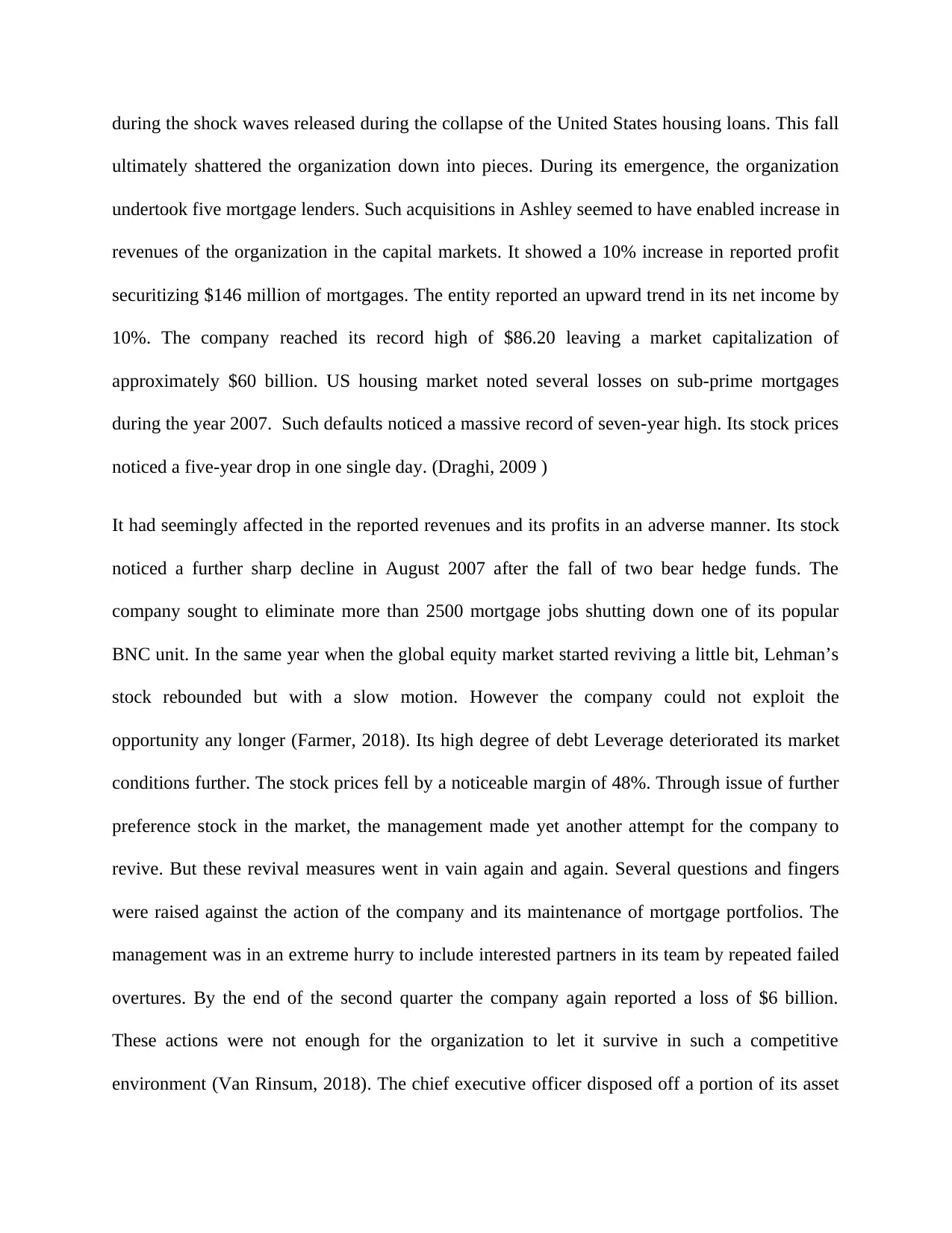
during the shock waves released during the collapse of the United States housing loans. This fall
ultimately shattered the organization down into pieces. During its emergence, the organization
undertook five mortgage lenders. Such acquisitions in Ashley seemed to have enabled increase in
revenues of the organization in the capital markets. It showed a 10% increase in reported profit
securitizing $146 million of mortgages. The entity reported an upward trend in its net income by
10%. The company reached its record high of $86.20 leaving a market capitalization of
approximately $60 billion. US housing market noted several losses on sub-prime mortgages
during the year 2007. Such defaults noticed a massive record of seven-year high. Its stock prices
noticed a five-year drop in one single day. (Draghi, 2009 )
It had seemingly affected in the reported revenues and its profits in an adverse manner. Its stock
noticed a further sharp decline in August 2007 after the fall of two bear hedge funds. The
company sought to eliminate more than 2500 mortgage jobs shutting down one of its popular
BNC unit. In the same year when the global equity market started reviving a little bit, Lehman’s
stock rebounded but with a slow motion. However the company could not exploit the
opportunity any longer (Farmer, 2018). Its high degree of debt Leverage deteriorated its market
conditions further. The stock prices fell by a noticeable margin of 48%. Through issue of further
preference stock in the market, the management made yet another attempt for the company to
revive. But these revival measures went in vain again and again. Several questions and fingers
were raised against the action of the company and its maintenance of mortgage portfolios. The
management was in an extreme hurry to include interested partners in its team by repeated failed
overtures. By the end of the second quarter the company again reported a loss of $6 billion.
These actions were not enough for the organization to let it survive in such a competitive
environment (Van Rinsum, 2018). The chief executive officer disposed off a portion of its asset
ultimately shattered the organization down into pieces. During its emergence, the organization
undertook five mortgage lenders. Such acquisitions in Ashley seemed to have enabled increase in
revenues of the organization in the capital markets. It showed a 10% increase in reported profit
securitizing $146 million of mortgages. The entity reported an upward trend in its net income by
10%. The company reached its record high of $86.20 leaving a market capitalization of
approximately $60 billion. US housing market noted several losses on sub-prime mortgages
during the year 2007. Such defaults noticed a massive record of seven-year high. Its stock prices
noticed a five-year drop in one single day. (Draghi, 2009 )
It had seemingly affected in the reported revenues and its profits in an adverse manner. Its stock
noticed a further sharp decline in August 2007 after the fall of two bear hedge funds. The
company sought to eliminate more than 2500 mortgage jobs shutting down one of its popular
BNC unit. In the same year when the global equity market started reviving a little bit, Lehman’s
stock rebounded but with a slow motion. However the company could not exploit the
opportunity any longer (Farmer, 2018). Its high degree of debt Leverage deteriorated its market
conditions further. The stock prices fell by a noticeable margin of 48%. Through issue of further
preference stock in the market, the management made yet another attempt for the company to
revive. But these revival measures went in vain again and again. Several questions and fingers
were raised against the action of the company and its maintenance of mortgage portfolios. The
management was in an extreme hurry to include interested partners in its team by repeated failed
overtures. By the end of the second quarter the company again reported a loss of $6 billion.
These actions were not enough for the organization to let it survive in such a competitive
environment (Van Rinsum, 2018). The chief executive officer disposed off a portion of its asset
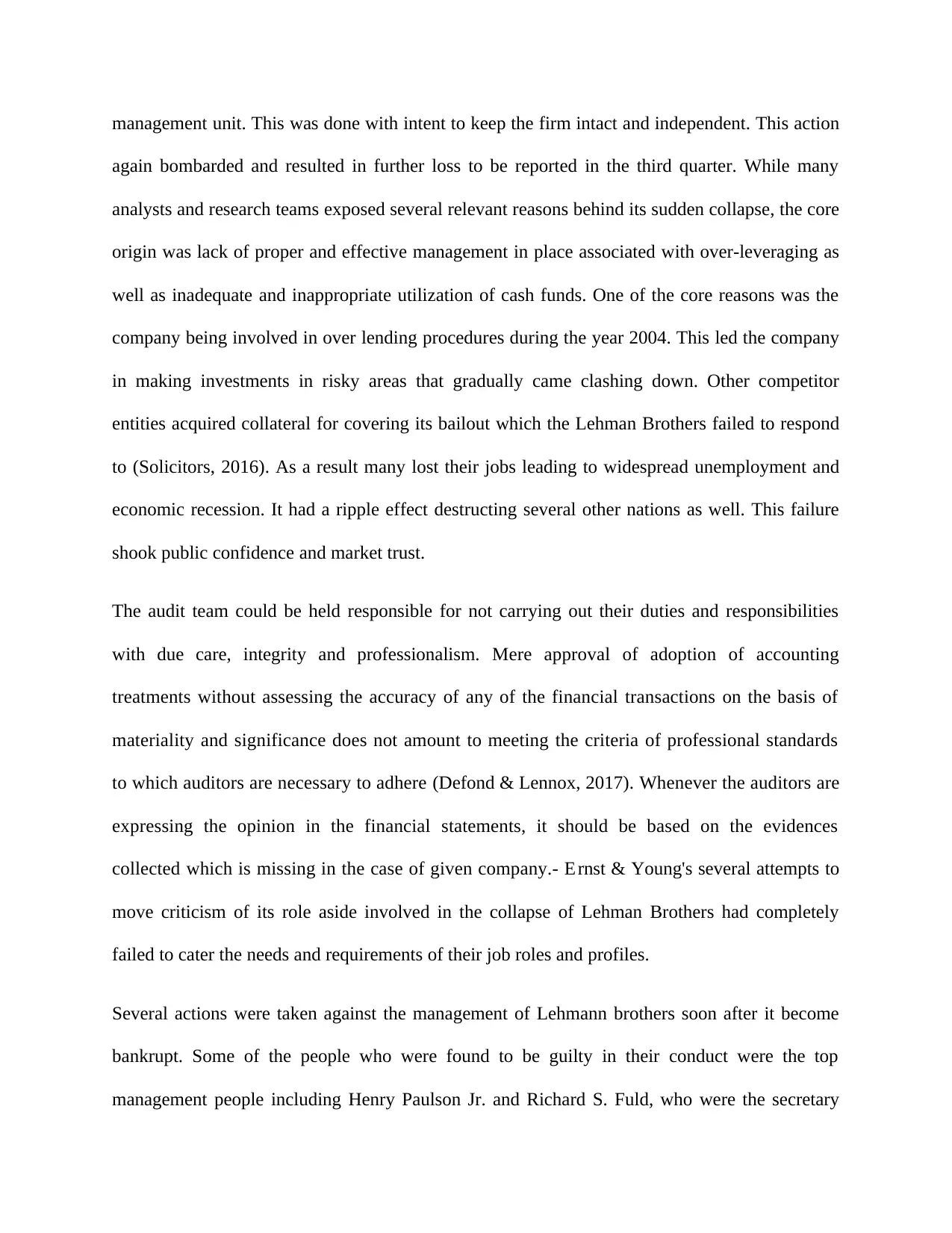
management unit. This was done with intent to keep the firm intact and independent. This action
again bombarded and resulted in further loss to be reported in the third quarter. While many
analysts and research teams exposed several relevant reasons behind its sudden collapse, the core
origin was lack of proper and effective management in place associated with over-leveraging as
well as inadequate and inappropriate utilization of cash funds. One of the core reasons was the
company being involved in over lending procedures during the year 2004. This led the company
in making investments in risky areas that gradually came clashing down. Other competitor
entities acquired collateral for covering its bailout which the Lehman Brothers failed to respond
to (Solicitors, 2016). As a result many lost their jobs leading to widespread unemployment and
economic recession. It had a ripple effect destructing several other nations as well. This failure
shook public confidence and market trust.
The audit team could be held responsible for not carrying out their duties and responsibilities
with due care, integrity and professionalism. Mere approval of adoption of accounting
treatments without assessing the accuracy of any of the financial transactions on the basis of
materiality and significance does not amount to meeting the criteria of professional standards
to which auditors are necessary to adhere (Defond & Lennox, 2017). Whenever the auditors are
expressing the opinion in the financial statements, it should be based on the evidences
collected which is missing in the case of given company.- E rnst & Young's several attempts to
move criticism of its role aside involved in the collapse of Lehman Brothers had completely
failed to cater the needs and requirements of their job roles and profiles.
Several actions were taken against the management of Lehmann brothers soon after it become
bankrupt. Some of the people who were found to be guilty in their conduct were the top
management people including Henry Paulson Jr. and Richard S. Fuld, who were the secretary
again bombarded and resulted in further loss to be reported in the third quarter. While many
analysts and research teams exposed several relevant reasons behind its sudden collapse, the core
origin was lack of proper and effective management in place associated with over-leveraging as
well as inadequate and inappropriate utilization of cash funds. One of the core reasons was the
company being involved in over lending procedures during the year 2004. This led the company
in making investments in risky areas that gradually came clashing down. Other competitor
entities acquired collateral for covering its bailout which the Lehman Brothers failed to respond
to (Solicitors, 2016). As a result many lost their jobs leading to widespread unemployment and
economic recession. It had a ripple effect destructing several other nations as well. This failure
shook public confidence and market trust.
The audit team could be held responsible for not carrying out their duties and responsibilities
with due care, integrity and professionalism. Mere approval of adoption of accounting
treatments without assessing the accuracy of any of the financial transactions on the basis of
materiality and significance does not amount to meeting the criteria of professional standards
to which auditors are necessary to adhere (Defond & Lennox, 2017). Whenever the auditors are
expressing the opinion in the financial statements, it should be based on the evidences
collected which is missing in the case of given company.- E rnst & Young's several attempts to
move criticism of its role aside involved in the collapse of Lehman Brothers had completely
failed to cater the needs and requirements of their job roles and profiles.
Several actions were taken against the management of Lehmann brothers soon after it become
bankrupt. Some of the people who were found to be guilty in their conduct were the top
management people including Henry Paulson Jr. and Richard S. Fuld, who were the secretary
⊘ This is a preview!⊘
Do you want full access?
Subscribe today to unlock all pages.

Trusted by 1+ million students worldwide
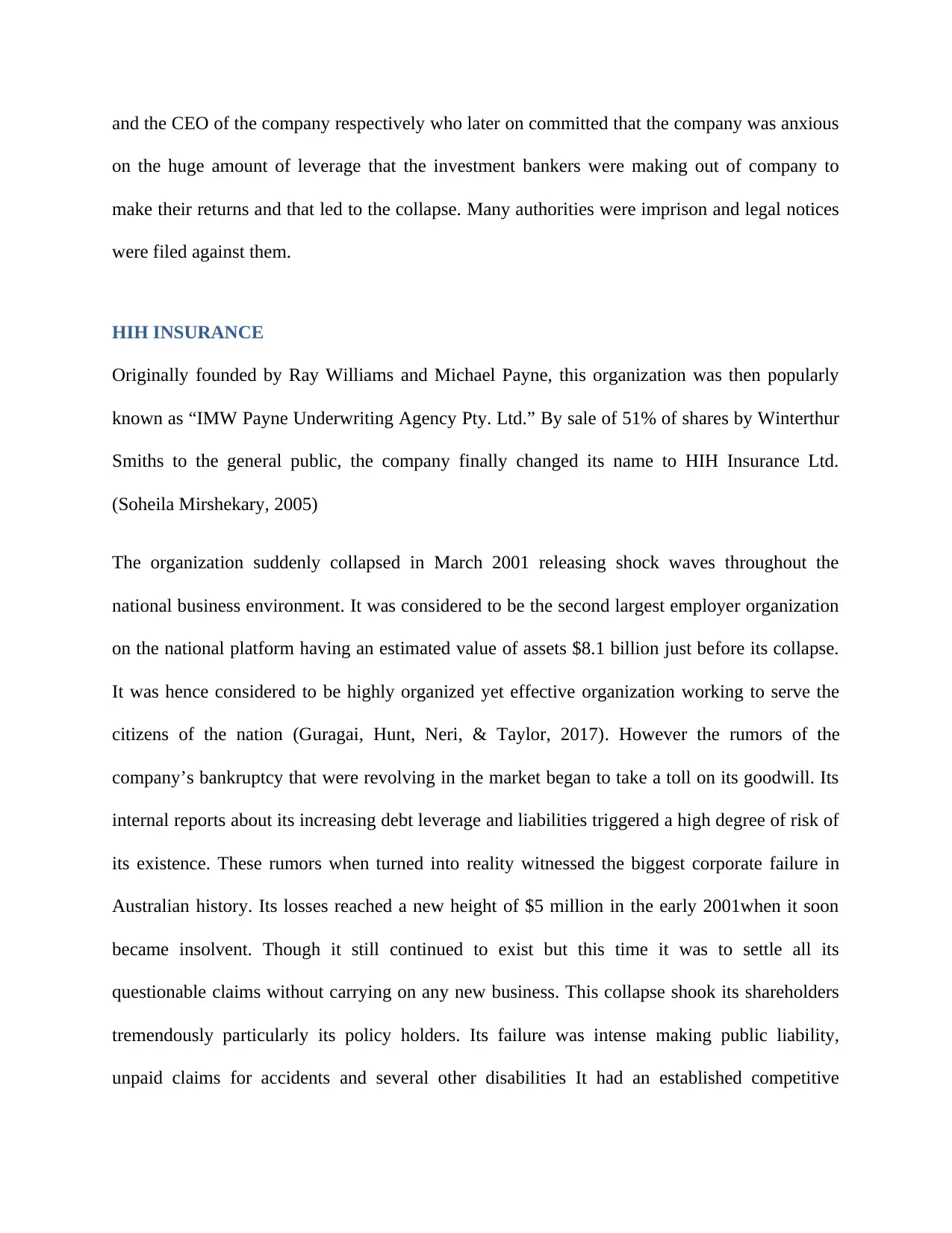
and the CEO of the company respectively who later on committed that the company was anxious
on the huge amount of leverage that the investment bankers were making out of company to
make their returns and that led to the collapse. Many authorities were imprison and legal notices
were filed against them.
HIH INSURANCE
Originally founded by Ray Williams and Michael Payne, this organization was then popularly
known as “IMW Payne Underwriting Agency Pty. Ltd.” By sale of 51% of shares by Winterthur
Smiths to the general public, the company finally changed its name to HIH Insurance Ltd.
(Soheila Mirshekary, 2005)
The organization suddenly collapsed in March 2001 releasing shock waves throughout the
national business environment. It was considered to be the second largest employer organization
on the national platform having an estimated value of assets $8.1 billion just before its collapse.
It was hence considered to be highly organized yet effective organization working to serve the
citizens of the nation (Guragai, Hunt, Neri, & Taylor, 2017). However the rumors of the
company’s bankruptcy that were revolving in the market began to take a toll on its goodwill. Its
internal reports about its increasing debt leverage and liabilities triggered a high degree of risk of
its existence. These rumors when turned into reality witnessed the biggest corporate failure in
Australian history. Its losses reached a new height of $5 million in the early 2001when it soon
became insolvent. Though it still continued to exist but this time it was to settle all its
questionable claims without carrying on any new business. This collapse shook its shareholders
tremendously particularly its policy holders. Its failure was intense making public liability,
unpaid claims for accidents and several other disabilities It had an established competitive
on the huge amount of leverage that the investment bankers were making out of company to
make their returns and that led to the collapse. Many authorities were imprison and legal notices
were filed against them.
HIH INSURANCE
Originally founded by Ray Williams and Michael Payne, this organization was then popularly
known as “IMW Payne Underwriting Agency Pty. Ltd.” By sale of 51% of shares by Winterthur
Smiths to the general public, the company finally changed its name to HIH Insurance Ltd.
(Soheila Mirshekary, 2005)
The organization suddenly collapsed in March 2001 releasing shock waves throughout the
national business environment. It was considered to be the second largest employer organization
on the national platform having an estimated value of assets $8.1 billion just before its collapse.
It was hence considered to be highly organized yet effective organization working to serve the
citizens of the nation (Guragai, Hunt, Neri, & Taylor, 2017). However the rumors of the
company’s bankruptcy that were revolving in the market began to take a toll on its goodwill. Its
internal reports about its increasing debt leverage and liabilities triggered a high degree of risk of
its existence. These rumors when turned into reality witnessed the biggest corporate failure in
Australian history. Its losses reached a new height of $5 million in the early 2001when it soon
became insolvent. Though it still continued to exist but this time it was to settle all its
questionable claims without carrying on any new business. This collapse shook its shareholders
tremendously particularly its policy holders. Its failure was intense making public liability,
unpaid claims for accidents and several other disabilities It had an established competitive
Paraphrase This Document
Need a fresh take? Get an instant paraphrase of this document with our AI Paraphraser
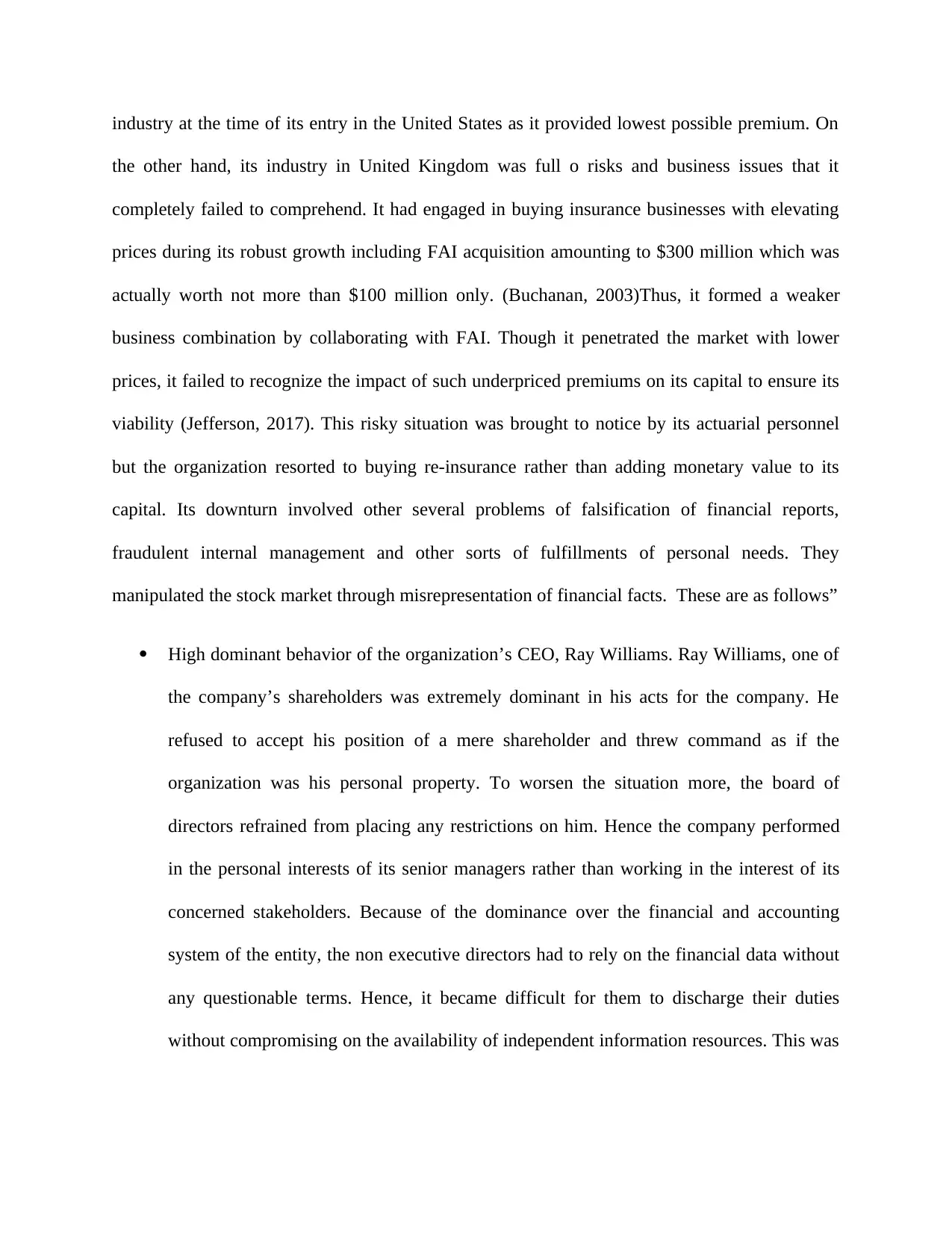
industry at the time of its entry in the United States as it provided lowest possible premium. On
the other hand, its industry in United Kingdom was full o risks and business issues that it
completely failed to comprehend. It had engaged in buying insurance businesses with elevating
prices during its robust growth including FAI acquisition amounting to $300 million which was
actually worth not more than $100 million only. (Buchanan, 2003)Thus, it formed a weaker
business combination by collaborating with FAI. Though it penetrated the market with lower
prices, it failed to recognize the impact of such underpriced premiums on its capital to ensure its
viability (Jefferson, 2017). This risky situation was brought to notice by its actuarial personnel
but the organization resorted to buying re-insurance rather than adding monetary value to its
capital. Its downturn involved other several problems of falsification of financial reports,
fraudulent internal management and other sorts of fulfillments of personal needs. They
manipulated the stock market through misrepresentation of financial facts. These are as follows”
High dominant behavior of the organization’s CEO, Ray Williams. Ray Williams, one of
the company’s shareholders was extremely dominant in his acts for the company. He
refused to accept his position of a mere shareholder and threw command as if the
organization was his personal property. To worsen the situation more, the board of
directors refrained from placing any restrictions on him. Hence the company performed
in the personal interests of its senior managers rather than working in the interest of its
concerned stakeholders. Because of the dominance over the financial and accounting
system of the entity, the non executive directors had to rely on the financial data without
any questionable terms. Hence, it became difficult for them to discharge their duties
without compromising on the availability of independent information resources. This was
the other hand, its industry in United Kingdom was full o risks and business issues that it
completely failed to comprehend. It had engaged in buying insurance businesses with elevating
prices during its robust growth including FAI acquisition amounting to $300 million which was
actually worth not more than $100 million only. (Buchanan, 2003)Thus, it formed a weaker
business combination by collaborating with FAI. Though it penetrated the market with lower
prices, it failed to recognize the impact of such underpriced premiums on its capital to ensure its
viability (Jefferson, 2017). This risky situation was brought to notice by its actuarial personnel
but the organization resorted to buying re-insurance rather than adding monetary value to its
capital. Its downturn involved other several problems of falsification of financial reports,
fraudulent internal management and other sorts of fulfillments of personal needs. They
manipulated the stock market through misrepresentation of financial facts. These are as follows”
High dominant behavior of the organization’s CEO, Ray Williams. Ray Williams, one of
the company’s shareholders was extremely dominant in his acts for the company. He
refused to accept his position of a mere shareholder and threw command as if the
organization was his personal property. To worsen the situation more, the board of
directors refrained from placing any restrictions on him. Hence the company performed
in the personal interests of its senior managers rather than working in the interest of its
concerned stakeholders. Because of the dominance over the financial and accounting
system of the entity, the non executive directors had to rely on the financial data without
any questionable terms. Hence, it became difficult for them to discharge their duties
without compromising on the availability of independent information resources. This was
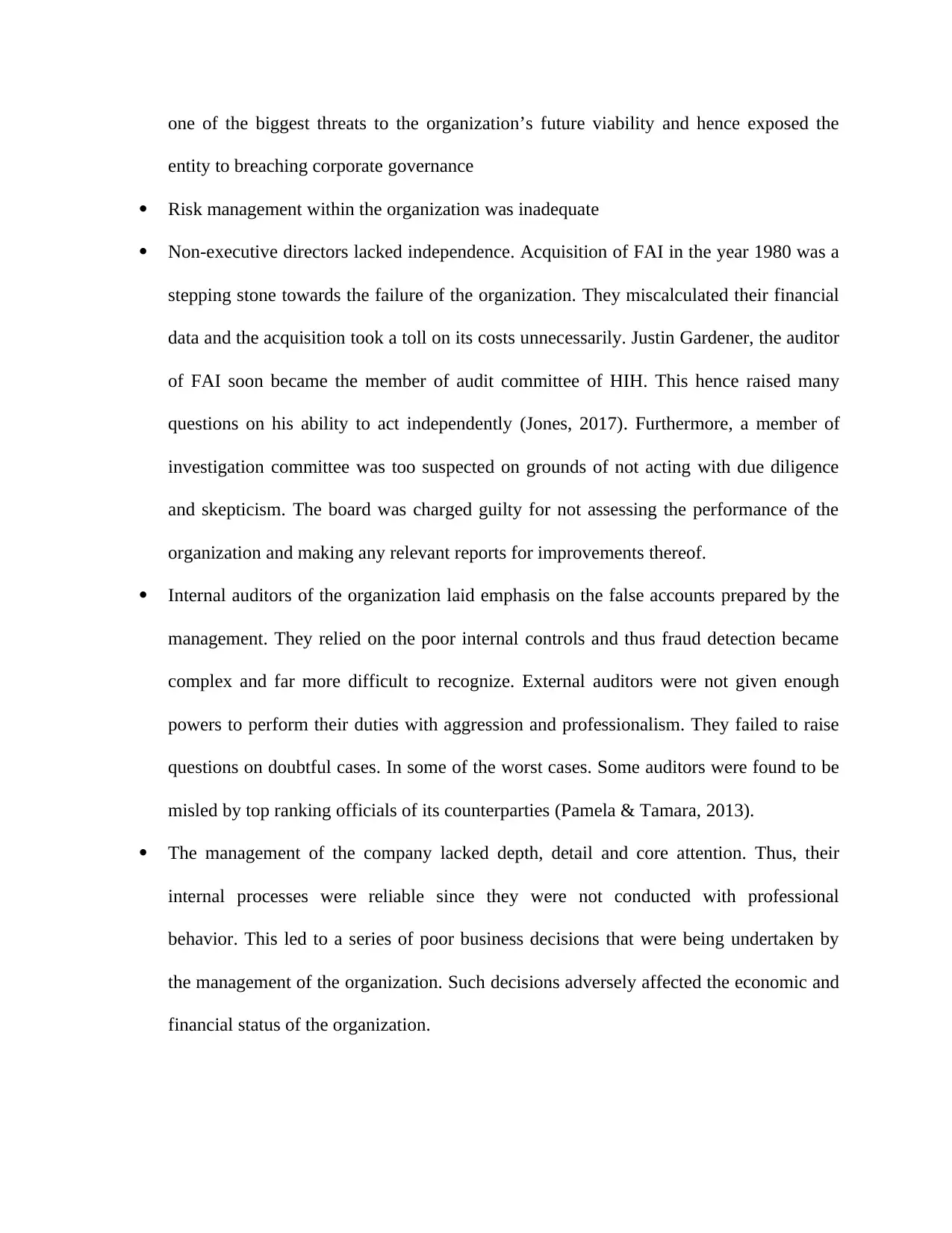
one of the biggest threats to the organization’s future viability and hence exposed the
entity to breaching corporate governance
Risk management within the organization was inadequate
Non-executive directors lacked independence. Acquisition of FAI in the year 1980 was a
stepping stone towards the failure of the organization. They miscalculated their financial
data and the acquisition took a toll on its costs unnecessarily. Justin Gardener, the auditor
of FAI soon became the member of audit committee of HIH. This hence raised many
questions on his ability to act independently (Jones, 2017). Furthermore, a member of
investigation committee was too suspected on grounds of not acting with due diligence
and skepticism. The board was charged guilty for not assessing the performance of the
organization and making any relevant reports for improvements thereof.
Internal auditors of the organization laid emphasis on the false accounts prepared by the
management. They relied on the poor internal controls and thus fraud detection became
complex and far more difficult to recognize. External auditors were not given enough
powers to perform their duties with aggression and professionalism. They failed to raise
questions on doubtful cases. In some of the worst cases. Some auditors were found to be
misled by top ranking officials of its counterparties (Pamela & Tamara, 2013).
The management of the company lacked depth, detail and core attention. Thus, their
internal processes were reliable since they were not conducted with professional
behavior. This led to a series of poor business decisions that were being undertaken by
the management of the organization. Such decisions adversely affected the economic and
financial status of the organization.
entity to breaching corporate governance
Risk management within the organization was inadequate
Non-executive directors lacked independence. Acquisition of FAI in the year 1980 was a
stepping stone towards the failure of the organization. They miscalculated their financial
data and the acquisition took a toll on its costs unnecessarily. Justin Gardener, the auditor
of FAI soon became the member of audit committee of HIH. This hence raised many
questions on his ability to act independently (Jones, 2017). Furthermore, a member of
investigation committee was too suspected on grounds of not acting with due diligence
and skepticism. The board was charged guilty for not assessing the performance of the
organization and making any relevant reports for improvements thereof.
Internal auditors of the organization laid emphasis on the false accounts prepared by the
management. They relied on the poor internal controls and thus fraud detection became
complex and far more difficult to recognize. External auditors were not given enough
powers to perform their duties with aggression and professionalism. They failed to raise
questions on doubtful cases. In some of the worst cases. Some auditors were found to be
misled by top ranking officials of its counterparties (Pamela & Tamara, 2013).
The management of the company lacked depth, detail and core attention. Thus, their
internal processes were reliable since they were not conducted with professional
behavior. This led to a series of poor business decisions that were being undertaken by
the management of the organization. Such decisions adversely affected the economic and
financial status of the organization.
⊘ This is a preview!⊘
Do you want full access?
Subscribe today to unlock all pages.

Trusted by 1+ million students worldwide
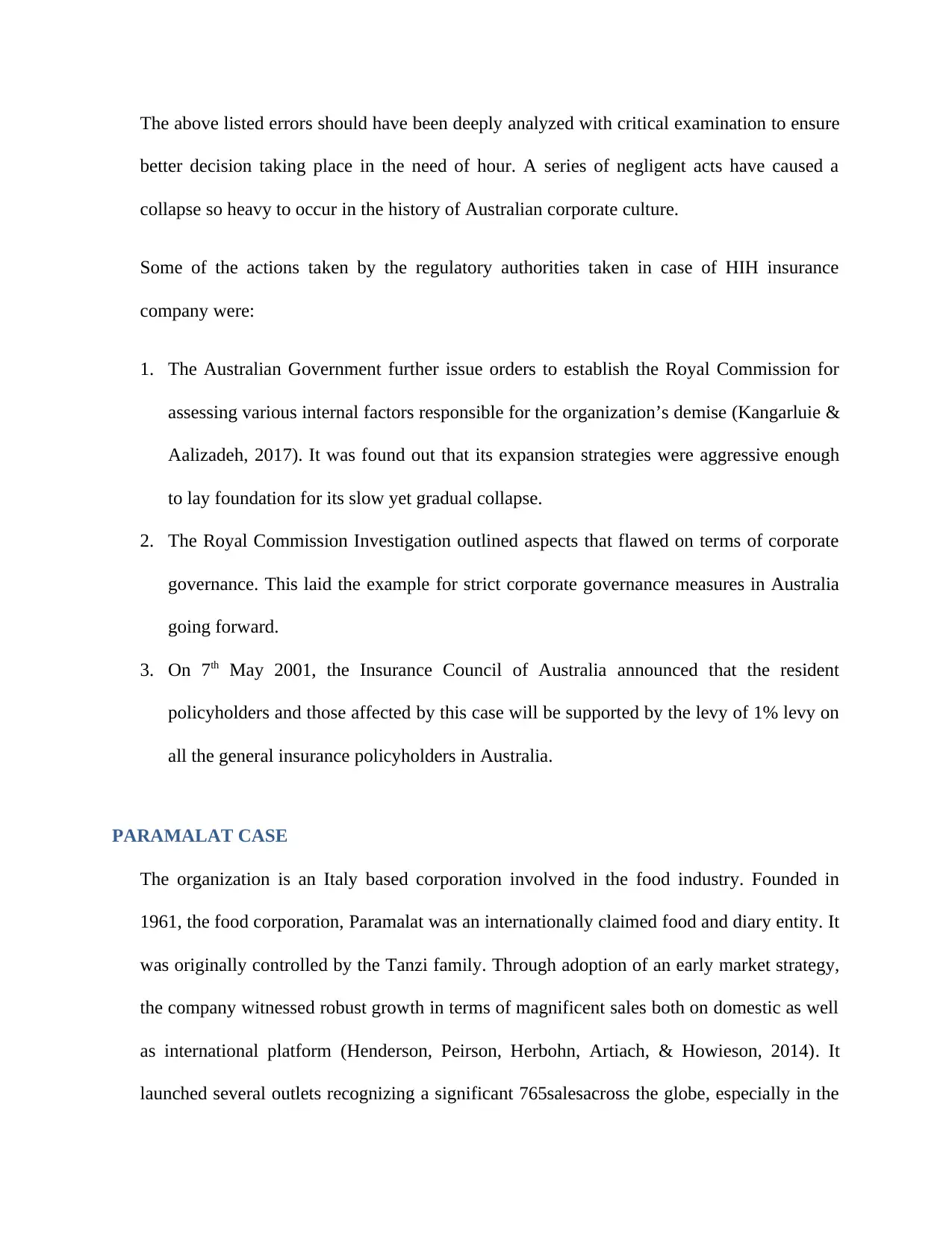
The above listed errors should have been deeply analyzed with critical examination to ensure
better decision taking place in the need of hour. A series of negligent acts have caused a
collapse so heavy to occur in the history of Australian corporate culture.
Some of the actions taken by the regulatory authorities taken in case of HIH insurance
company were:
1. The Australian Government further issue orders to establish the Royal Commission for
assessing various internal factors responsible for the organization’s demise (Kangarluie &
Aalizadeh, 2017). It was found out that its expansion strategies were aggressive enough
to lay foundation for its slow yet gradual collapse.
2. The Royal Commission Investigation outlined aspects that flawed on terms of corporate
governance. This laid the example for strict corporate governance measures in Australia
going forward.
3. On 7th May 2001, the Insurance Council of Australia announced that the resident
policyholders and those affected by this case will be supported by the levy of 1% levy on
all the general insurance policyholders in Australia.
PARAMALAT CASE
The organization is an Italy based corporation involved in the food industry. Founded in
1961, the food corporation, Paramalat was an internationally claimed food and diary entity. It
was originally controlled by the Tanzi family. Through adoption of an early market strategy,
the company witnessed robust growth in terms of magnificent sales both on domestic as well
as international platform (Henderson, Peirson, Herbohn, Artiach, & Howieson, 2014). It
launched several outlets recognizing a significant 765salesacross the globe, especially in the
better decision taking place in the need of hour. A series of negligent acts have caused a
collapse so heavy to occur in the history of Australian corporate culture.
Some of the actions taken by the regulatory authorities taken in case of HIH insurance
company were:
1. The Australian Government further issue orders to establish the Royal Commission for
assessing various internal factors responsible for the organization’s demise (Kangarluie &
Aalizadeh, 2017). It was found out that its expansion strategies were aggressive enough
to lay foundation for its slow yet gradual collapse.
2. The Royal Commission Investigation outlined aspects that flawed on terms of corporate
governance. This laid the example for strict corporate governance measures in Australia
going forward.
3. On 7th May 2001, the Insurance Council of Australia announced that the resident
policyholders and those affected by this case will be supported by the levy of 1% levy on
all the general insurance policyholders in Australia.
PARAMALAT CASE
The organization is an Italy based corporation involved in the food industry. Founded in
1961, the food corporation, Paramalat was an internationally claimed food and diary entity. It
was originally controlled by the Tanzi family. Through adoption of an early market strategy,
the company witnessed robust growth in terms of magnificent sales both on domestic as well
as international platform (Henderson, Peirson, Herbohn, Artiach, & Howieson, 2014). It
launched several outlets recognizing a significant 765salesacross the globe, especially in the
Paraphrase This Document
Need a fresh take? Get an instant paraphrase of this document with our AI Paraphraser
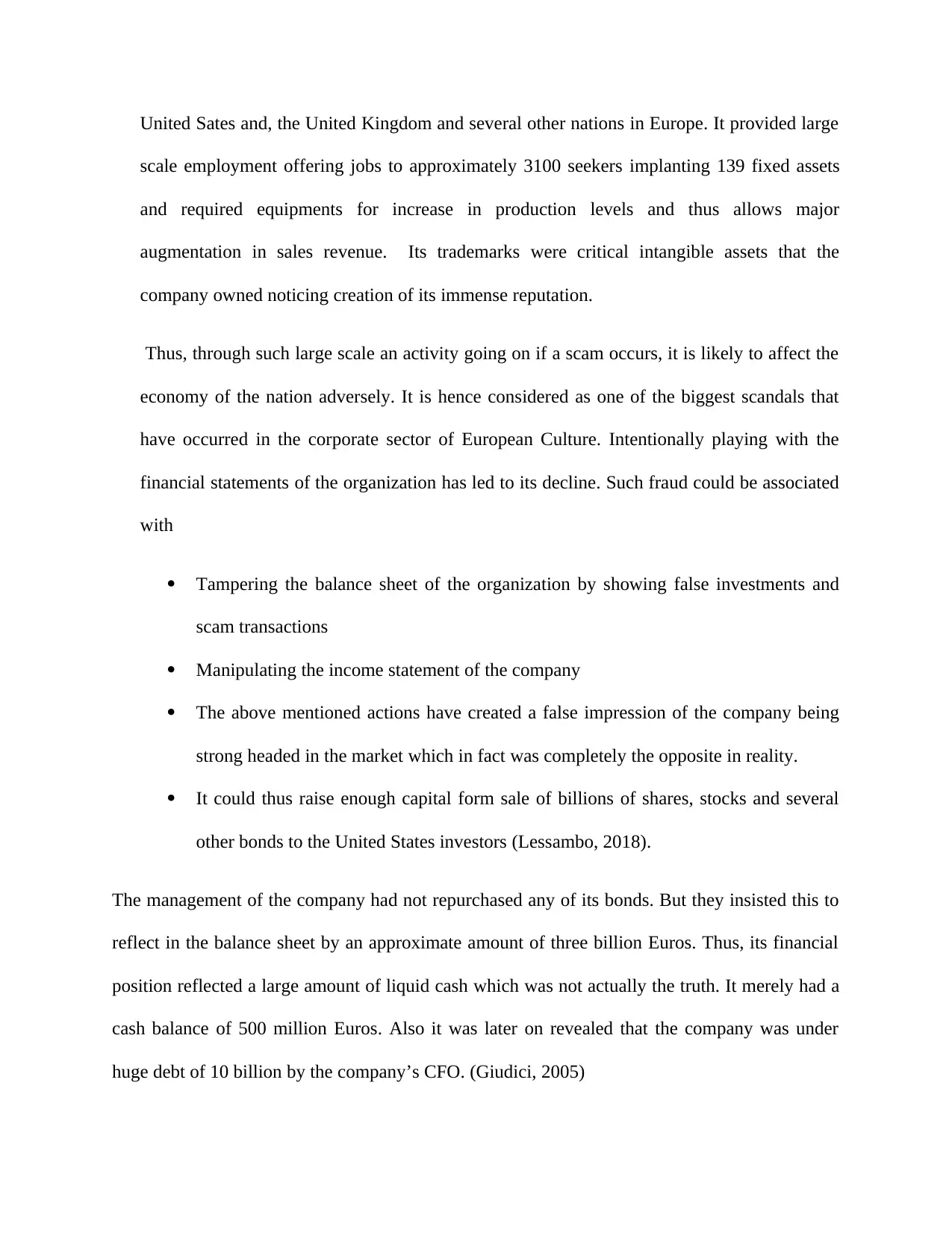
United Sates and, the United Kingdom and several other nations in Europe. It provided large
scale employment offering jobs to approximately 3100 seekers implanting 139 fixed assets
and required equipments for increase in production levels and thus allows major
augmentation in sales revenue. Its trademarks were critical intangible assets that the
company owned noticing creation of its immense reputation.
Thus, through such large scale an activity going on if a scam occurs, it is likely to affect the
economy of the nation adversely. It is hence considered as one of the biggest scandals that
have occurred in the corporate sector of European Culture. Intentionally playing with the
financial statements of the organization has led to its decline. Such fraud could be associated
with
Tampering the balance sheet of the organization by showing false investments and
scam transactions
Manipulating the income statement of the company
The above mentioned actions have created a false impression of the company being
strong headed in the market which in fact was completely the opposite in reality.
It could thus raise enough capital form sale of billions of shares, stocks and several
other bonds to the United States investors (Lessambo, 2018).
The management of the company had not repurchased any of its bonds. But they insisted this to
reflect in the balance sheet by an approximate amount of three billion Euros. Thus, its financial
position reflected a large amount of liquid cash which was not actually the truth. It merely had a
cash balance of 500 million Euros. Also it was later on revealed that the company was under
huge debt of 10 billion by the company’s CFO. (Giudici, 2005)
scale employment offering jobs to approximately 3100 seekers implanting 139 fixed assets
and required equipments for increase in production levels and thus allows major
augmentation in sales revenue. Its trademarks were critical intangible assets that the
company owned noticing creation of its immense reputation.
Thus, through such large scale an activity going on if a scam occurs, it is likely to affect the
economy of the nation adversely. It is hence considered as one of the biggest scandals that
have occurred in the corporate sector of European Culture. Intentionally playing with the
financial statements of the organization has led to its decline. Such fraud could be associated
with
Tampering the balance sheet of the organization by showing false investments and
scam transactions
Manipulating the income statement of the company
The above mentioned actions have created a false impression of the company being
strong headed in the market which in fact was completely the opposite in reality.
It could thus raise enough capital form sale of billions of shares, stocks and several
other bonds to the United States investors (Lessambo, 2018).
The management of the company had not repurchased any of its bonds. But they insisted this to
reflect in the balance sheet by an approximate amount of three billion Euros. Thus, its financial
position reflected a large amount of liquid cash which was not actually the truth. It merely had a
cash balance of 500 million Euros. Also it was later on revealed that the company was under
huge debt of 10 billion by the company’s CFO. (Giudici, 2005)
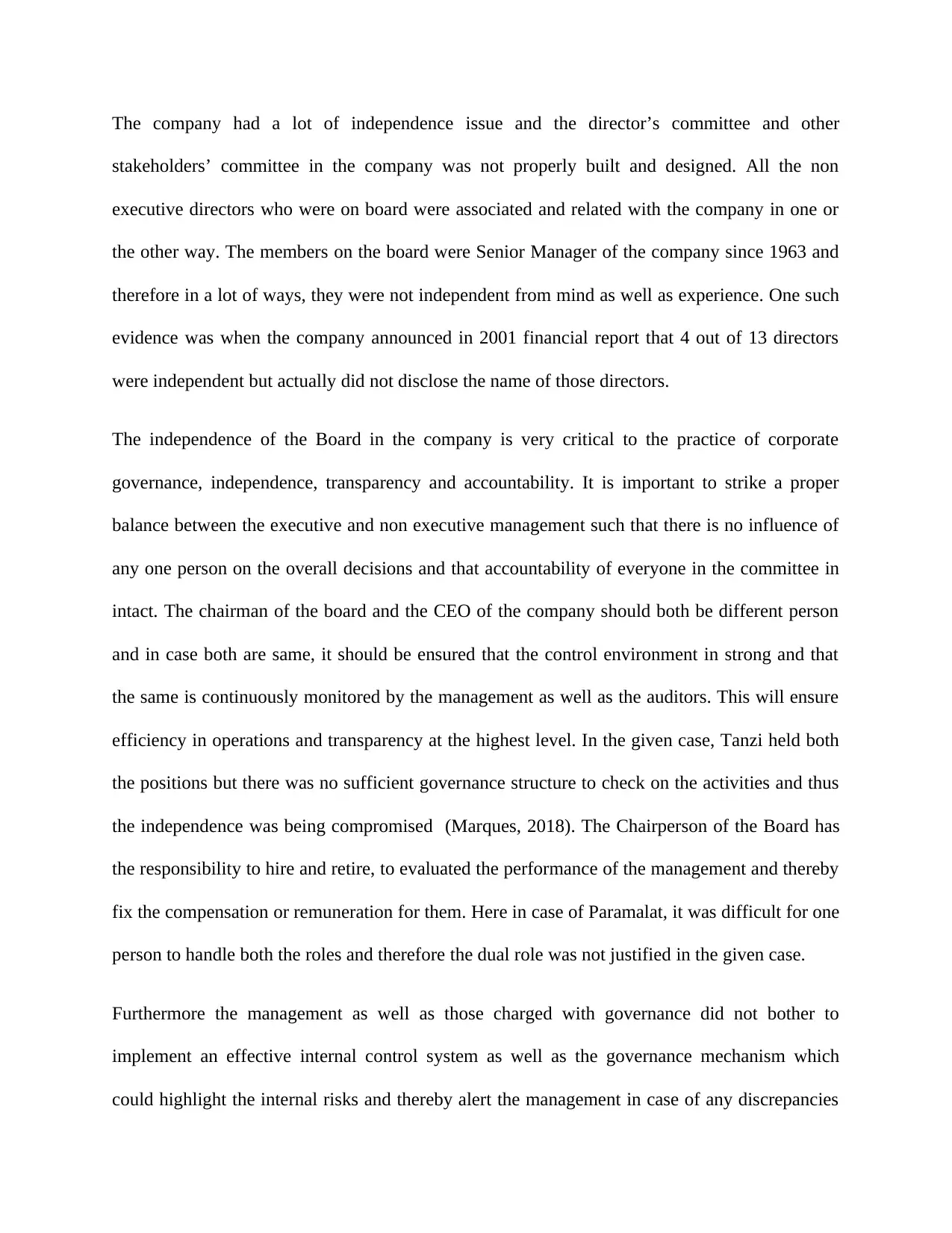
The company had a lot of independence issue and the director’s committee and other
stakeholders’ committee in the company was not properly built and designed. All the non
executive directors who were on board were associated and related with the company in one or
the other way. The members on the board were Senior Manager of the company since 1963 and
therefore in a lot of ways, they were not independent from mind as well as experience. One such
evidence was when the company announced in 2001 financial report that 4 out of 13 directors
were independent but actually did not disclose the name of those directors.
The independence of the Board in the company is very critical to the practice of corporate
governance, independence, transparency and accountability. It is important to strike a proper
balance between the executive and non executive management such that there is no influence of
any one person on the overall decisions and that accountability of everyone in the committee in
intact. The chairman of the board and the CEO of the company should both be different person
and in case both are same, it should be ensured that the control environment in strong and that
the same is continuously monitored by the management as well as the auditors. This will ensure
efficiency in operations and transparency at the highest level. In the given case, Tanzi held both
the positions but there was no sufficient governance structure to check on the activities and thus
the independence was being compromised (Marques, 2018). The Chairperson of the Board has
the responsibility to hire and retire, to evaluated the performance of the management and thereby
fix the compensation or remuneration for them. Here in case of Paramalat, it was difficult for one
person to handle both the roles and therefore the dual role was not justified in the given case.
Furthermore the management as well as those charged with governance did not bother to
implement an effective internal control system as well as the governance mechanism which
could highlight the internal risks and thereby alert the management in case of any discrepancies
stakeholders’ committee in the company was not properly built and designed. All the non
executive directors who were on board were associated and related with the company in one or
the other way. The members on the board were Senior Manager of the company since 1963 and
therefore in a lot of ways, they were not independent from mind as well as experience. One such
evidence was when the company announced in 2001 financial report that 4 out of 13 directors
were independent but actually did not disclose the name of those directors.
The independence of the Board in the company is very critical to the practice of corporate
governance, independence, transparency and accountability. It is important to strike a proper
balance between the executive and non executive management such that there is no influence of
any one person on the overall decisions and that accountability of everyone in the committee in
intact. The chairman of the board and the CEO of the company should both be different person
and in case both are same, it should be ensured that the control environment in strong and that
the same is continuously monitored by the management as well as the auditors. This will ensure
efficiency in operations and transparency at the highest level. In the given case, Tanzi held both
the positions but there was no sufficient governance structure to check on the activities and thus
the independence was being compromised (Marques, 2018). The Chairperson of the Board has
the responsibility to hire and retire, to evaluated the performance of the management and thereby
fix the compensation or remuneration for them. Here in case of Paramalat, it was difficult for one
person to handle both the roles and therefore the dual role was not justified in the given case.
Furthermore the management as well as those charged with governance did not bother to
implement an effective internal control system as well as the governance mechanism which
could highlight the internal risks and thereby alert the management in case of any discrepancies
⊘ This is a preview!⊘
Do you want full access?
Subscribe today to unlock all pages.

Trusted by 1+ million students worldwide
1 out of 16
Related Documents
Your All-in-One AI-Powered Toolkit for Academic Success.
+13062052269
info@desklib.com
Available 24*7 on WhatsApp / Email
![[object Object]](/_next/static/media/star-bottom.7253800d.svg)
Unlock your academic potential
Copyright © 2020–2025 A2Z Services. All Rights Reserved. Developed and managed by ZUCOL.





